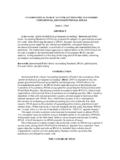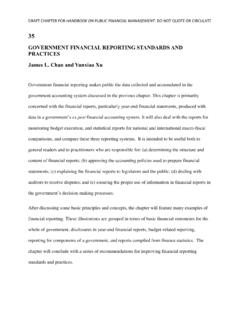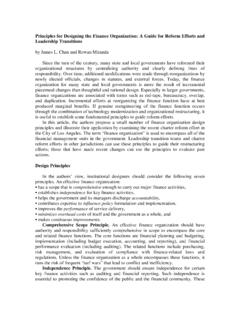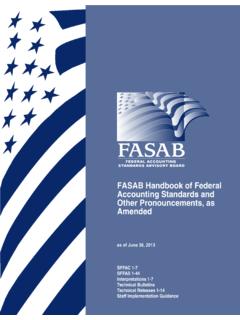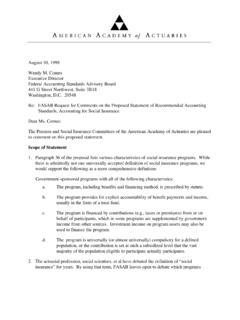Transcription of Chapter 4 STANDARD-SETTING INSTITUTIONS, DUE …
1 AMERICAN GOVERNMENT accounting standards by James L. Chan All rights reserved. For class use only. Do not distribute further without permission. 1 Chapter 4 STANDARD-SETTING INSTITUTIONS, DUE PROCESS, AND OUTPUTS INTRODUCTION The Governmental accounting standards Board (GASB) and the federal accounting standards advisory Board (FASAB) set generally accepted accounting principles applicable to state and local governments and to the federal Government, respectively. Their standards are used to design accounting systems, and regulate accounting measurements and the form and content of financial statements.
2 Auditors also use them to judge the quality of financial statements in order to express audit opinions. Following the previous description of the circumstances surrounding their establishment, this Chapter will discuss these boards missions, scope and authority, organizational structure, standard setting process, and outputs. Even though STANDARD-SETTING bodies such as the GASB and FASAB are few in number and unique in many ways, they are also organizations that can be analyzed using the stakeholder theory described in Chapter 2. This Chapter will therefore begin with a conceptual analysis of accounting standards board, followed by a description of the GASB and FASAB.
3 The Chapter concludes with a comparison of the boards in terms of their similarities and differences. INSTITUTIONAL ANALYSIS OF accounting standards BOARDS Exhibit is an application of the basic systems framework to government accounting standard setting. The GASB and the FASAB in their deliberation processes convert ideas, made available by political and economic resources, into standards as outputs. If these standards are favorably received, their adopters may be inclined to provide support to the standard setters, thus completing the resource conversion and reconversion Exhibit standards Board as a System Political resources Economic resources Information resources FASAB GASB GAAP for Government Reconversion Inputs Conversion Outputs AMERICAN GOVERNMENT accounting standards by James L.
4 Chan All rights reserved. For class use only. Do not distribute further without permission. 2 Exhibit directs our attention to the following questions: Who provides economic resources, political resources, and information resources to the GASB and FASAB? How do GASB and FASAB produce their standards ? What are the characteristics of the standards that impress stakeholders so that they are motivated to provide additional resources to the GASB and FASAB? The concepts in Exhibit are operationalized in the context of accounting standards boards. The results of this institutional analysis are summarized in Exhibit Exhibit Elements of Institutional Analysis Systems Approach Institutional Analysis of accounting standards Boards Political resources legal authority professional authoritativeness endorsement of influential persons Economic resources financial resources human resources.
5 Members, staff, and contributors to research and technical activities infrastructure and administrative support Information resources contextual knowledge of responses to proposed standards technical knowledge of the extent to which proposed standards meet objectives Conversion research and technical activities to generate alternatives deliberation of the merits of alternatives due process of soliciting comments on alternatives consensus formation and voting Outputs Documents containing standards and related materials Practice guidance and educational materials Reconversion Marketing of
6 standards through public discourse Acceptance, endorsement of standards Use of standards in designing and modifying systems Use of standards in preparing financial reports Use of standards in auditing financial statements Using Exhibit as a guide, the next two sections describe the federal accounting standards advisory Board (FASAB) and the Governmental accounting standards Board (GASB), using mostly publicly available information about the boards. THE federal accounting standards advisory BOARD This section describes the federal accounting standards advisory Board (FASAB) in terms of its goals, jurisdiction, resources, decision-making process and outputs, based on the board s Mission, Domain and Authority AMERICAN GOVERNMENT accounting standards by James L.
7 Chan All rights reserved. For class use only. Do not distribute further without permission. 3 The mission of the FASAB is to develop accounting standards after considering the financial and budgetary information needs of congressional oversight groups, executive agencies, and the needs of other uses of federal financial information. accounting and financial reporting standards are essential for public accountability and for an efficient and effective functioning of our democratic system of government. Thus federal accounting standards and financial reporting play a major role in fulfilling the government s duty to be publicly accountable and can be used to (1) assess the government s accountability, and its efficiency and effectiveness, and (2) contribute to the understanding of the economic, political, and social consequences of the allocation and various uses of federal resources (FASAB Facts, 2006).
8 The domain of FASAB s standards lies almost entirely in financial accounting . The Memorandum of Understanding (MOU) that established the FASAB specifically prohibits the board from setting or proposing federal concepts, standards and proposals. (MOU, May 7, 2003). The FASAB does not have legal authority on its own. The Sponsors agree that standards set and promulgated following the Board s Rules of Procedures are recognized to have substantial authoritative support, .. The Sponsors retain their authorities, separately and jointly, to establish and adopt accounting standards for the federal government (MOU, May 7, 2003).
9 Therefore, the following review and clearance process is currently in place: When the Board has developed a proposed concept or standard, the Board shall submit it to the Comptroller General, the Director of OMB [Office of Management and Budget], the Secretary of the Treasury, and the Director of the CBO [Office of Congressional Budget] for their review. If, within 90 days after its submission, the Comptroller General or the Director, or both, objects to the concept or standard, then it shall not be issued, and will be returned to the Board for further consideration.
10 If, within 90 days after its submission, neither of these officials objects to the concepts or standard, then it shall be issued and become a final concept or standard of the Board. Concepts and standards will be announced in the federal (MOU, May 7, 2003). In July 2006, the 90-day review period was extended for another 90 days when circumstances require. Furthermore, the Chief Financial Officers Act of 1990 requires capital accounting standards be submitted to Congress for a mandatory 45-day review (FASAB News, January-March 2000). The membership of the FASAB and the professional status of the board s standards underwent significant changes during the period between 2000 and 2003 in connection with the AICIPA s recognition of FASAB standards as generally accepted accounting principles.
